For those who have a disability, getting around can sometimes be difficult. There will be times when they need to get to upper floors as they can’t be expected to just stay on ground floors forever.
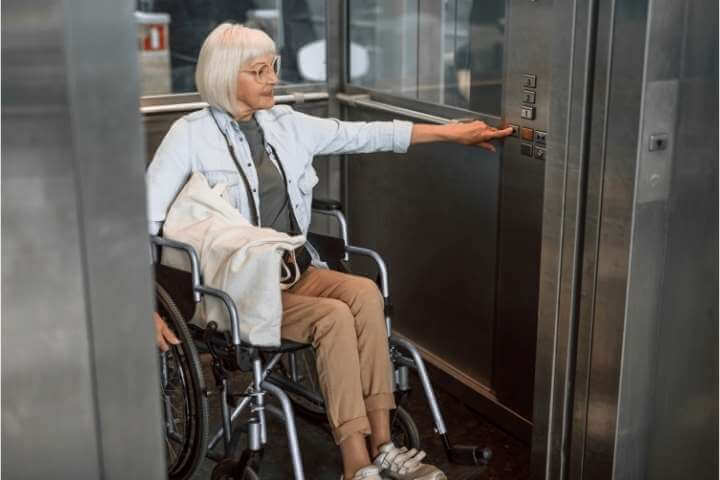
One of the assistive devices that helps those with mobility difficulty are elevators, as then they don’t have to try to take the stairs and potentially hurt themselves.
There are certain parts of using an elevator that those with disabilities may find difficult whereas those who don’t have a disability may not even realize it’s a barrier for others.
The Americans with Disabilities act has given guidelines for the requirements of an elevator to be ADA compliant, and therefore accessible to those with any disability.
Do All Buildings Need To Have Elevators That Are ADA Compliant?
In short, no. Some buildings may be exempt from these requirements.
A couple examples of exempt buildings are if they have fewer than three stories to them or if there is less than 3,000 sq feet per floor.
Of course there are some buildings that fall into this category where the elevators still need to be ADA compliant.
- Public transit station
- Health care provider office or clinic
- Professional office building
- Shopping center/mall
- Airport terminal
Minimal Modifications Needed For Most Elevators
Historically, certain modifications would need to be made to existing elevators to ensure that they are accessible to those who have a disability.
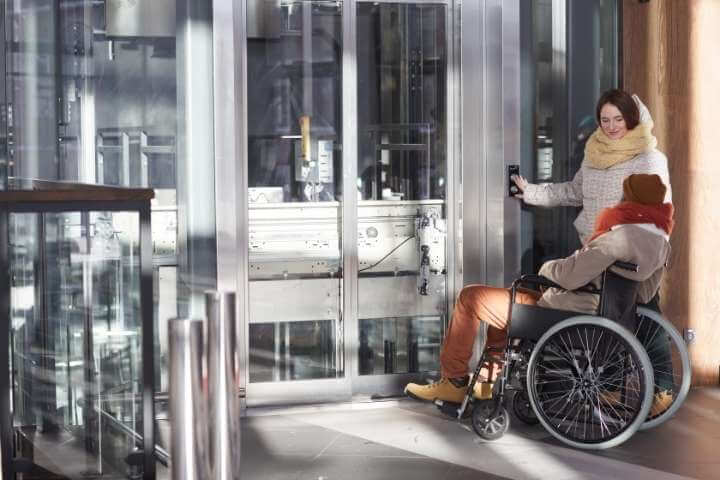
Thankfully today, the majority of elevators are manufactured so that they meet ADA compliance without any modifications needed during or after installation.
This means that building owners know they are getting the best user experience for the customers or tenants, and they can save money because they don’t have to do any remodelling or renovations in the future to make the elevators ADA compliant.
So, What Are The Requirements For An ADA Compliant Elevator?
If you’re looking to purchase a new elevator for your building, you will want to make sure the purchase you make follows the regulations.
This can help you avoid fines and penalties in the future if your elevator is found to be non-compliant, or not meet the requirements exactly.
Before you make that big purchase (because elevators are expensive to purchase), here are the requirements for an elevator to be ADA compliant.
- The elevator has to be in a space where it’s easily accessible by everyone, and can’t be in a cramped hallway.
- The doors have to stay completely open for a minimum of 3 seconds.
- The call buttons in the elevator have to be at least 0.75 inches in diameter.
- The height of the buttons have to be centered 42 inches from the floor of the elevator.
- The car of the elevator has to be at least 51 inches deep and 68 inches wide to allow for a wheelchair or other assistive device to properly maneuver around inside.
- The doors have to be at least 36 inches wide.
- On the control panel where the floors are selected, the braille has to be below or directly next to its corresponding number or floor
- There must be two-way communication in the elevator car that those who are blind or deaf can use.
- A verbal announcement of the stop/floor, or an audible signal of some sort must be used to signal the passing floors.
- All emergency controls for the elevator must be grouped together, and at the bottom of the control panel. Additionally, these buttons must not be any less than 35 inches from the floor of the elevator car.
The majority of elevator manufacturers will make their elevators like this when you order, so you won’t have to ask for these specific requirements.
There are some unique technology that will differ between manufacturers, however in meeting ADA requirements their set up will meet these above criteria.
Destination-Oriented Elevators
Some professional buildings have implemented what they call destination-oriented elevators for groups of people who are all going to the same floor, or same range of floors.
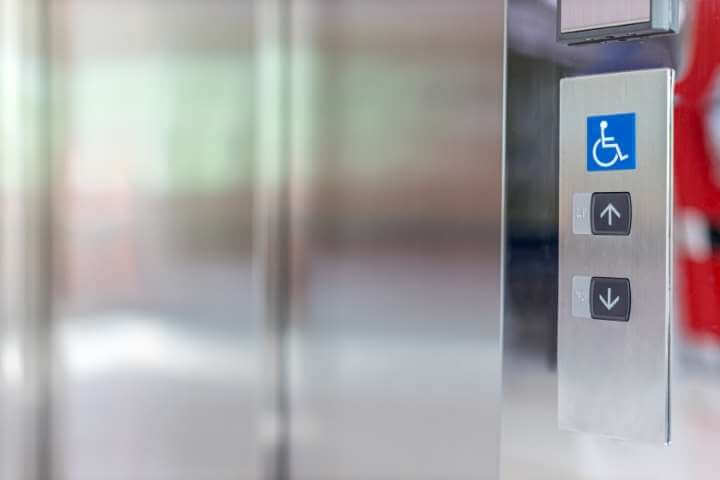
This type of elevator has become very popular for large office buildings that constantly have people come and going and that have many, many floors to them.
These elevators will have audible signals to let occupants know when they have reached the right floor and also when they are in the lobby/main floor.
With their increasing popularity, the ADA has had to review the requirements for buildings that are using destination-oriented elevators.
They came to the conclusion that these types of elevators must be held to the same standard are all other elevators to be ADA compliant, with some additional requirements
- Visual display of each floor in which that particular elevator car has been programmed to stop at
- Automatic announcement, or verbal signal, at each stop
- An audible and visual differentiation of the elevators in a bank of elevators so that people will know which one to use.
Limited Use Elevators
Another type of elevator is what’s known as a limited use, or limited application, elevator. These types of elevators are typically found in very large commercial buildings.
They are designed for very low occupancy and are usually only manufactured to take occupants up one or two floors.
These types of elevators are usually found in libraries, churches or small businesses.
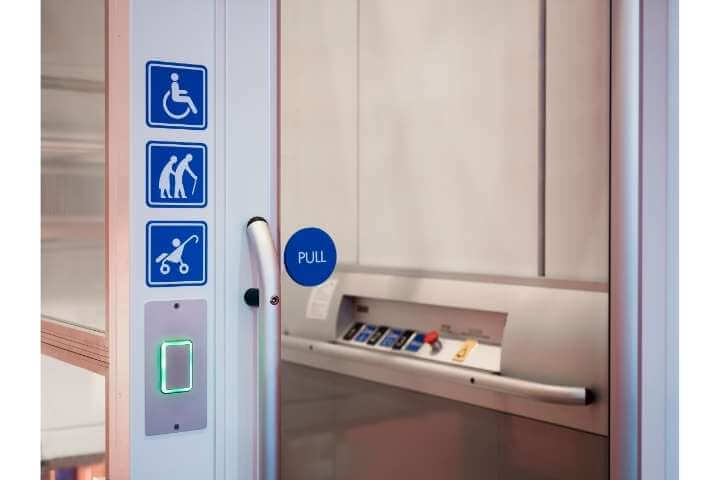
What’s great about these elevators is that they can retrofitted to old buildings to give accessibility to the upper floors where there may not have been accessibility previously.
When an old building is renovated or modified, the ADA requires that any accessibility barriers currently in place be removed, where it’s feasible, so that the building becomes ADA compliant.
If you, as a building owner, aren’t sure about what’s considered feasible and what must be removed from the building to be totally ADA compliant there is a self-assessment to determine what these barriers might be.
While this self-assessment isn’t mandatory by the ADA, it’s well worth it to be able to determine what the best ways to give the access that is required and therefore reduce your overall liability.
The assessment also shows that you are trying you best to make sure your building or business is ADA compliant, so almost like a show of good faith.
When this assessment is done, it would be helpful to include people who have disabilities so they can identify what may be a barrier to them. For people who don’t have a disability, something may seem like it’s a non-issue but those with a disability can shed light on the barriers they experience.
As per the ADA, limited access elevators are held to the same standard that conventional elevators are however they typically travel shorter distances at slower speeds and may have slightly smaller car sizes.
Common ADA Elevator Violations
Even though most companies will do their best to make sure the elevators in their buildings are ADA compliant and they are accessible to everyone, there can still be some small oversight – even if they are unintentional.
Main Floor Indicator
The button for the main exit level is required to have a start on the button, and it has to be raised with braille. This is to indicate to those with visual impairment how to get out of the building if they need to – this is the main exit floor.
Refuge Area
While this may not be directly about an elevator, it is a really important ADA regulation. The reason it’s important is because those with a disability may not be able to use the stairs to fully evacuate the building, and a safe place is needed for them to take refuge in the event of an emergency.
It has been reported that many buildings don’t have designated areas of refuge for patrons to wait when there’s an emergency but a full evacuation isn’t possible.
The areas of refuge should be big enough to accommodate a wheelchair, and there should be one for every 200 occupants of the building. These areas should also feature a 2-way communication system for patrons who are taking refuge to communicate with the outside world.
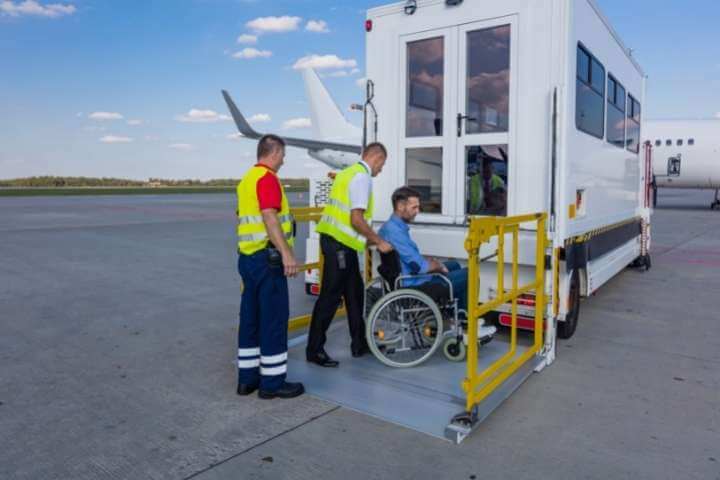
How Do You Make Sure Your Elevator Is ADA Compliant?
As mentioned, buildings that are found to be in violation of the ADA regulations can be subject to major fines and be forced to change the elevator to make sure it meets the specifications.
If you have concerns about the renovation or update you’re doing, it’s best to contact the ADA directly and see if they have someone who can come out and take a look.
They can also give you direction on certain elevator manufacturers and even models they recommend and have found to be the best when it comes to the user experience for people with disabilities.
It would be better to wait just a couple days, or a week, and have someone ensure your renovations are going to be compliant than to do all of it and end up having to do more renovations because it wasn’t compliant in the first place.
When your building has accessible elevators, the experience for those with disabilities will be that much better and they will be more likely to come back and use your business or tell others about it.
